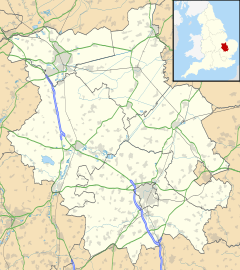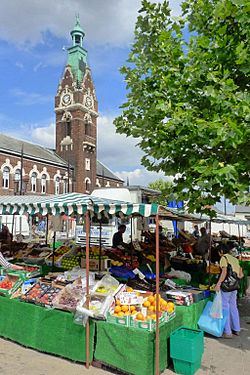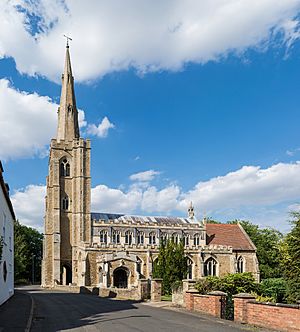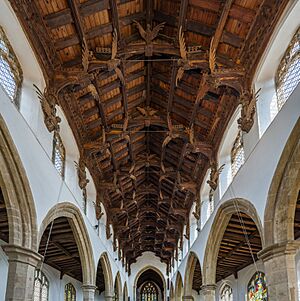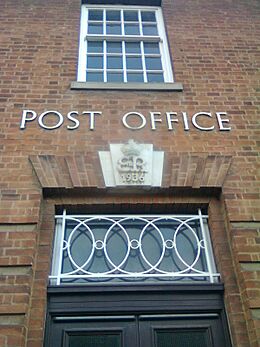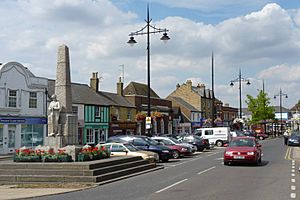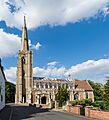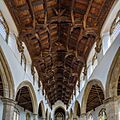March, Cambridgeshire facts for kids
Quick facts for kids March |
|
|---|---|
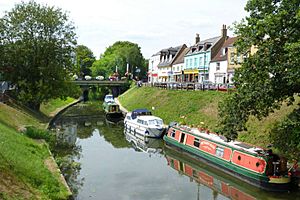 March High Street bridge over the River Nene |
|
| Population | 22,970 (2021 Census) |
| OS grid reference | TL4196 |
| Civil parish |
|
| District |
|
| Shire county | |
| Region | |
| Country | England |
| Sovereign state | United Kingdom |
| Post town | MARCH |
| Postcode district | PE15 |
| Dialling code | 01354 |
| Police | Cambridgeshire |
| Fire | Cambridgeshire |
| Ambulance | East of England |
| EU Parliament | East of England |
| UK Parliament |
|
March is a town in the Fens area of Cambridgeshire, England. It's known as a market town. For many years, it was the main town of the Isle of Ely, which was a separate local government area. Today, the main offices for Fenland District Council are in March.
The town grew a lot because it became a very important railway hub. Like many places in the Fens, March was once like an island. It was surrounded by marshy lands. As people drained the land, March grew bigger and became a busy place for trade and religion. It was also a small port before the railways arrived. March is located on the old path of the River Nene. This river is now mostly used by boats for fun.
Contents
Discover the History of March
March was first written about in the Domesday Book in 1086. Its name, Merche, might come from an old English word meaning 'boundary'. Modern March is built along the Fen Causeway, which was a Roman road. We know that Romans lived in this area a long time ago.
Before the Fens were drained, March was like an island in the wet marshlands. The town likely started because there was a place to cross the River Nene. This crossing was on the road between Ely and Wisbech. These were the two main towns in the Isle of Ely. For a while, boats on the River Nene were important for trade in March. But this changed when railways came in the 1800s.
A bridge with one arch was built over the River Nene in 1850. This bridge is at the north end of the town. High Street, the main road, goes over this bridge to Broad Street. The Causeway road has many beautiful trees lining it.
A theatre was built in March in 1826 by Joseph Smedley.
HM Prison Whitemoor, a secure facility, opened near March in 1991.
How March is Governed
March has three levels of local government. These are the town council, the district council, and the county council.
- March Town Council looks after local things like allotments. They also support band concerts and own the March Museum. The town council is based at March Town Hall. A town mayor is chosen by councillors each May.
- Fenland District Council also has its main office in March, at Fenland Hall.
- Cambridgeshire County Council is the largest local government body.
- All these councils are part of the Cambridgeshire and Peterborough Combined Authority. This group is led by the Mayor of Cambridgeshire and Peterborough.
March is part of the North East Cambridgeshire area for national elections.
A Look at March's Local Government History
March used to be a small part of the Doddington area. This was in the North Witchford area of Cambridgeshire. In 1866, March became its own separate area. The Isle of Ely used to be controlled by the Bishop of Ely. But this control ended in 1837.
In 1851, a local board was set up to manage March. These boards became urban districts in 1894. The March Urban District Council built the Town Hall in 1900. This was their main office.
From 1889 to 1965, the Isle of Ely had its own council. This council chose March as its main base. They built County Hall in March in 1909. This building is now called Fenland Hall.
In 1974, the March Urban District was closed down. Its jobs were taken over by the new Fenland District Council. A new local council, March Town Council, was then created for the area.
March's Markets and Trade
March has a long history of trading. In the time of Queen Elizabeth I, March was a small port. In 1566, eight boats were used to carry coal and grain. In 1657, people saw barges carrying coal and other goods. March also had its own special coins, called tokens, in 1669 and 1811.
The first market was likely held near the old town centre, by The Causeway. A stone cross, now called The Stone Cross, shows where this early market was. It was put up in the early 1500s near St Wendreda's Church. In 1670, King Charles II gave permission for March to hold a market and two fairs each year. This was even though Wisbech didn't want it to happen. This market was held on Fridays. The Lord of the Manor of Doddington owned much of March. He let the townspeople sell their goods on his land in the town centre. This area is now called the Market Place.
In 1785, the market made about £6 a year. But soon after, the market stopped, though the fairs continued. The market didn't grow much because there was no covered hall. Also, market day in March was the same as in other nearby towns. In 1807, the local leaders said it was not clean to load goods near the market. They ordered all saw pits and timber to be moved. The market struggled, and an attempt to restart it in 1821 didn't work well.
A building called a Buttercross was built in 1831. This building also held the town's fire engine. It had an upstairs room that was once a school. Later, it was the Town Surveyor's Office. This office had a tower with the Town Clock. The clock was bought by the public around 1750. The Town Stocks, used to punish offenders, were also in the Market Place.
After the railway opened in 1847, another try was made to improve the market. By 1851, the market was "making progress." In 1856, market day was changed from Friday to Wednesday. This helped avoid clashing with other towns.
Fairs for hiring servants happened each autumn. These were also a chance to meet people. Shows and food stalls were set up. Many people came, which could also attract pickpockets.
In 1872, the local health board bought a steam fire engine. It was kept in the Market House. In the same year, they agreed to build a urinal for boys at the school.
By 1888, the market toll-keeper was taking about £50 a year. The market's success went up and down. In 1897, Sir Algernon Peyton agreed to sell the market rights to March Urban District Council for £800.
After changes to local government in 1974, the market rights went to Fenland District Council. Today, market days in March are Wednesday and Saturday.
Churches and Religion in March
March has eleven churches serving its people.
St Wendreda's Church
St Wendreda is the town's special saint. The oldest church in March is named after her. March is the only known church dedicated to St Wendreda. She was an Anglo-Saxon from the 600s. She might have been a daughter of King Anna of East Anglia. Two of her possible sisters, Etheldreda and Sexburgha, are more famous saints.
St Wendreda's holy items were kept in Ely Cathedral. But in 1016, they were taken into battle. People hoped they would help King Edmund Ironside win. However, King Canute's army captured them. He then gave them to Canterbury Cathedral. In 1343, the items were returned to March. But where they ended up is not known.
The church is famous for its amazing roof. It has 120 carved angels. Many people think it's one of the best roofs of its kind. John Betjeman, a famous writer, said the church was "worth cycling 40 miles in a head wind to see." The church teaches from the Bible.
Other Churches in March
In Victorian times, more Church of England churches were built closer to where people lived. Thomas Henry Wyatt designed St John's (1872), St Peter's (1881), and St Mary's (1874). These four churches in March now work together.
Trinity Church is a joint Methodist and United Reformed Church. It was built as a Methodist church in the late 1800s. It replaced a smaller chapel. In the 1980s, St Paul's Methodist Church became Trinity Church. This happened when it joined with the United Reformed Church and the Primitive Methodist church.
Centenary Baptist Church started in 1700. Providence Baptist Church was rebuilt in 1873.
An Elim Pentecostal Church meets at the March Community Centre. March Evangelical Fellowship meets on Upwell Road. Fenland Community Church helps people with learning difficulties.
Roman Catholics can attend weekly services in the Anglican church in Chatteris.
March Folklore
An old story says that in the 1200s, people in March tried to build a church. They wanted to build it where the Stone Cross stands now. But devils did not want them to. The devils thought the Fens belonged to them. As fast as the people built, the devils pulled it down. This went on for years. Then, the people of March put up the stone cross. This scared the devils away. The devils left the town, and that's how the cross came to be there.
March Museum
March has its own museum on the High Street. It is in a building that was once a girls' school in the 1850s. The Town Council bought the building in 1976. The Museum opened in 1977.
It is open every Saturday and Wednesday from 10:30 AM to 3:30 PM. The museum has many local items from March and nearby villages. These include the clock face from St Mary's Church in Benwick and a large collection of cameras.
Travel and Transport in March
Rivers
The town is on both sides of the River Nene (Old Course). There is a marina for narrow boats. You can also rent boats there.
Roads
March now has a western bypass road. This helps take the A141 and some traffic away from the town centre. The B1099 and B1101 roads also go through the town.
Railways
March was once a very important railway centre. It had a major meeting point for the Great Eastern Railway and Great Northern Railway. This was at March railway station. The station is about 87 miles (140 km) from London by train. It is also 32 miles (51 km) north of Cambridge and 16 miles (26 km) north west of Ely.
Whitemoor marshalling yards were built in the 1920s and 30s. They were once the second largest in Europe. They were the biggest in Britain. They slowly closed down in the 1960s and fully shut in 1990. HM Prison Whitemoor was built on part of this land.
The railway tracks from March to Wisbech are still there. In 2019, people were looking into reopening this line. The Campaign for Better Transport thinks this line should be reopened.
March March March Walk
The "March March march" is a 30-mile (48 km) walk. It goes from March to Cambridge. Students and teachers from the University of Cambridge have done this walk since 1979. They do it in the month of March. The walkers sing a special song called the "March March March March." The walk is done just for fun. There is also a shorter version called the May Manea Mania.
March Delivery Office
The March Royal Mail sorting office opened in 1936. It used to be a full post office. It is special because it shows the royal cypher (a king's symbol) of Edward VIII. He was king for only a short time. Only a few post offices have his symbol.
March's Economy and Shops
In the town centre, you can find many shops. These include independent stores and larger chains like W. H. Smith, Boyes, Boots, Sainsbury's, Lidl and Superdrug. New shops have also opened outside the town centre. In 2008, Meadowland retail park opened. It has stores like Argos, Mattressman, Carpetright, Halfords and The Original Factory Shop. Tesco also made its store much bigger.
March town centre has several places to eat and drink. In 2008, the Ye Olde Griffin Hotel became a "Smith & Jones" pub. It is now back to being called The Ye Olde Griffin Hotel. In 2011, J D Wetherspoon opened a pub in an old cinema and bingo hall.
The biggest employers in March are Whitemoor Prison, Tesco, Sainsbury's, and many food processing factories nearby.
Sports and Fun in March
March has a football club called March Town United. They play at the GER Sports Ground. They won the United Counties Division One title in 1953–54. They also won the Eastern Counties League in 1987-88.
Norwood Nature Reserve is a 6.5-acre (2.6 ha) area north of the railway station. It's a great place to enjoy nature.
Famous People from March
- William Barker (1817–1894), a gold prospector.
- Benjamin Gimbert (1903–1976), who received the George Cross award.
- Louise Hazel (born 1985), an athlete who competes in heptathlon.
- Wentworth M. Johnson (born 1939), a writer.
- Kevin Painter (born 1967), a darts player.
- Martin Peerson (around 1570–around 1650), a composer.
- Rex Tucker (1930–1996), a TV director.
- Eric Sherbrooke Walker (1887–1976), who owned Treetops Hotel.
- Jason Wing (born 1965), an Olympic bobsleigher.
- Terry Woodgate (1919–1985), a footballer.
Images for kids
See also
 In Spanish: March (Cambridgeshire) para niños
In Spanish: March (Cambridgeshire) para niños


